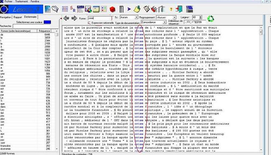Lexico: Difference between revisions
Jump to navigation
Jump to search
(Created page with "{{Data mining and learning analytics tools |field_logo= |field_screenshot= |field_name=Lexico |field_developers=Equipe SYLED-CLA2T, Université de la Sorbonne Nouvelle, Paris...") |
No edit summary |
||
| (2 intermediate revisions by one other user not shown) | |||
| Line 1: | Line 1: | ||
{{Data mining and learning analytics tools | {{Data mining and learning analytics tools | ||
|field_logo= | |field_logo=LexicoLOGO.gif | ||
|field_screenshot= | |field_screenshot=lexico3.png | ||
|field_name=Lexico | |field_name=Lexico | ||
|field_developers=Equipe SYLED-CLA2T, Université de la Sorbonne Nouvelle, Paris 3 | |field_developers=Equipe SYLED-CLA2T, Université de la Sorbonne Nouvelle, Paris 3 | ||
|field_website=http://www.tal.univ-paris3.fr/lexico/ | |field_website=http://www.tal.univ-paris3.fr/lexico/ | ||
| Line 14: | Line 14: | ||
|field_description=Quote from the [http://www.tal.univ-paris3.fr/lexico/index-gb.htm Home page]: {{quotation|Lexico3 is the 2001 edition of the Lexico software, first published in 1990. Functions present from the first version (segmentation, concordances, breakdown in graphic form, characteristic elements and factorial analyses of repeated forms and segments) were maintained and for the most part significantly improved. The Lexico series is unique in that it allows the user to maintain control over the entire lexicometric process from initial segmentation to the publication of final results. Beyond identification of graphic forms, the software allows for study of the identification of more complex units composed of form sequences: repeated segments, pairs of forms in co-occurrences, etc which are less ambiguous than the graphic forms that make them up.}} | |field_description=Quote from the [http://www.tal.univ-paris3.fr/lexico/index-gb.htm Home page]: {{quotation|Lexico3 is the 2001 edition of the Lexico software, first published in 1990. Functions present from the first version (segmentation, concordances, breakdown in graphic form, characteristic elements and factorial analyses of repeated forms and segments) were maintained and for the most part significantly improved. The Lexico series is unique in that it allows the user to maintain control over the entire lexicometric process from initial segmentation to the publication of final results. Beyond identification of graphic forms, the software allows for study of the identification of more complex units composed of form sequences: repeated segments, pairs of forms in co-occurrences, etc which are less ambiguous than the graphic forms that make them up.}} | ||
A free version is available for "personal work". | A free version is available for "personal work", bottom of [http://www.tal.univ-paris3.fr/lexico/download.htm this page] | ||
|field_analysis_orientation=General analysis | |field_analysis_orientation=General analysis | ||
|field_data_analysis_objective= | |field_data_analysis_objective= | ||
| Line 34: | Line 34: | ||
Lebart, L. & Salem, A. (1994). Statistique Textuelle, Dunod, 344 p. Epuisé, accessible en ligne, http://www.tal.univ-paris3.fr/lexico/ | Lebart, L. & Salem, A. (1994). Statistique Textuelle, Dunod, 344 p. Epuisé, accessible en ligne, http://www.tal.univ-paris3.fr/lexico/ | ||
== Bugs == | |||
Does not install on Windows 8 (even in Win XP compatibility mode) | |||



